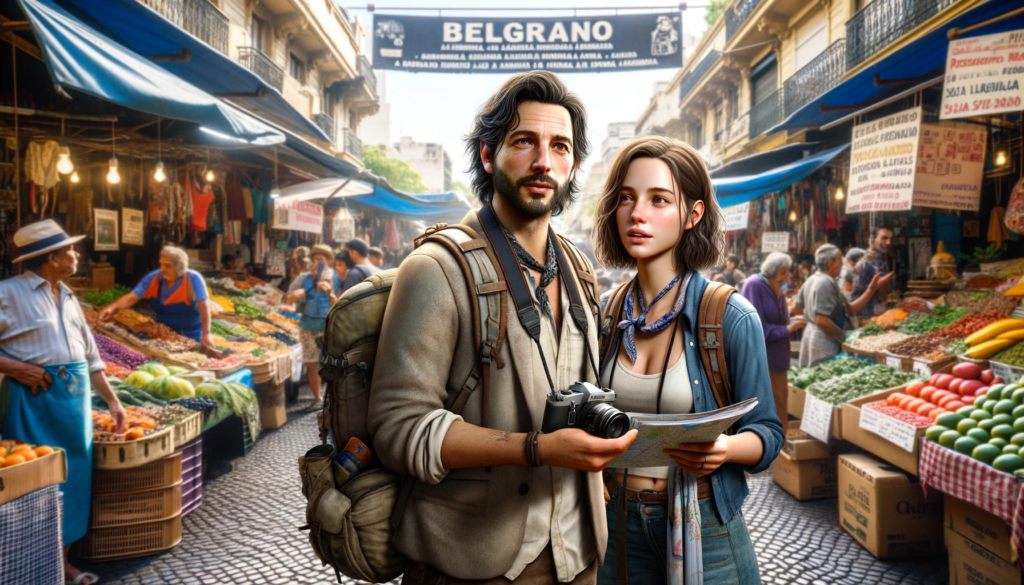Welcome to Belgrano! A neighborhood in the heart of Buenos Aires, Argentina’s capital city, that is both incredibly vibrant and steeped in history. Often overlooked by the average tourist, this hidden gem is a hub of culture, delicious food, and exciting sporting events. As you walk down the beautiful, tree-lined avenues of Belgrano, you will be amazed at the stunning architecture, the lively atmosphere, and the warm, welcoming people.
Belgrano is not just a neighborhood; it’s a community, an experience, a living breathing entity that is as diverse as it is unique. From the bustling street markets to the quiet, serene parks, from the historical landmarks to the cutting-edge restaurants, every inch of Belgrano offers something special.
So, get ready to uncover the secrets of Belgrano as we delve deep into the heart of Buenos Aires. Pack your bags, bring your curiosity, and let’s explore!
A Brief History of Belgrano
Belgrano’s history is as rich and multi-faceted as the neighborhood itself. Founded in the 1850s, it was initially an independent city until it was incorporated into Buenos Aires in 1880. During its early years, Belgrano was home to some of the wealthiest families in Argentina, and their grand mansions still dot the landscape today.
Underneath its modern cityscape, Belgrano has retained its historical charm. The old cobblestone streets, the colonial-style buildings, and the stately mansions tell the tales of a bygone era. Walking through the streets of Belgrano is like stepping back in time, a time when the city was just starting to find its feet.
Belgrano’s history is deeply intertwined with that of Argentina. Its vibrant past is reflected in its name, which honors General Manuel Belgrano, a key figure in Argentina’s struggle for independence.
Best Restaurants in Belgrano
Belgrano is a culinary paradise, blending traditional Argentinian cuisine with international flavors. Here, you’ll find restaurants serving everything from juicy steaks to delicate pastries, offering a gastronomical adventure for every palate.
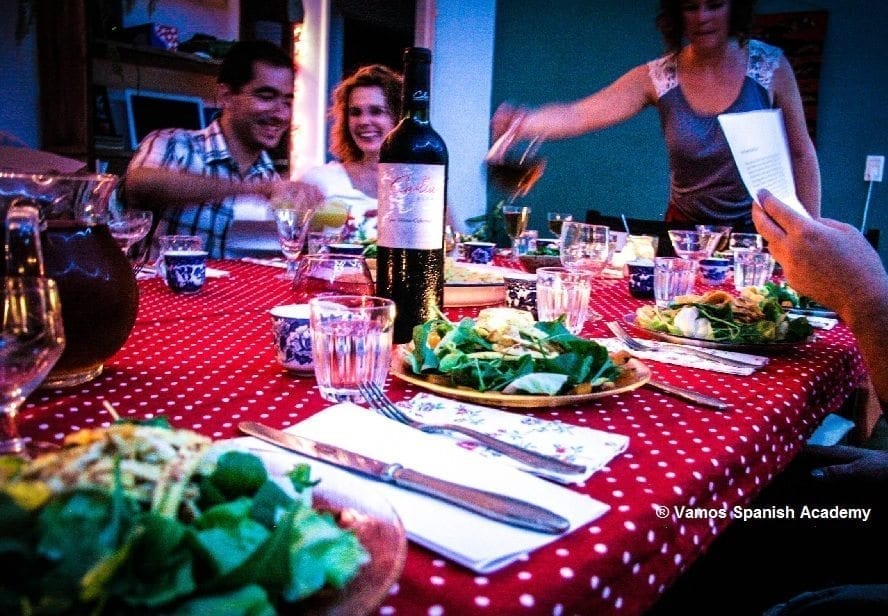
One of the most popular restaurants in Belgrano is El Boliche de Nico. This traditional Argentinian steakhouse is famous for its mouth-watering cuts of beef and its cozy, rustic atmosphere. The menu features a variety of dishes, but their specialty is the ‘asado’, a type of barbecued meat that’s a staple of Argentinian cuisine. Paired with a glass of Malbec, it’s a meal you won’t forget.
Another must-visit is Sudestada. This Asian fusion restaurant serves up a diverse menu of dishes inspired by the flavors of Southeast Asia. From spicy Thai curries to fresh Vietnamese spring rolls, every dish is a celebration of vibrant flavors and fresh ingredients. The restaurant’s minimalist, modern decor provides a chic backdrop for a memorable dining experience.
Exploring the Food Culture in Belgrano
Belgrano’s food scene is as diverse as the neighborhood itself. From traditional Argentinian fare to international cuisines, the district’s culinary landscape is a food lover’s paradise.
Also read about: Cooking Argentine Asado – Learn About History and Recipes
Chinatown, located in the heart of Belgrano, is a hub of Asian cuisine. Here, you can feast on delicious dim sum, sushi, and other Asian delicacies. The area is also known for its vibrant street markets, where you can find everything from fresh produce to exotic spices.
For a taste of traditional Argentinian cuisine, head to one of the many parrillas (barbecue restaurants) in the neighborhood. Here, you can savor mouth-watering steaks, empanadas, and other local favorites.
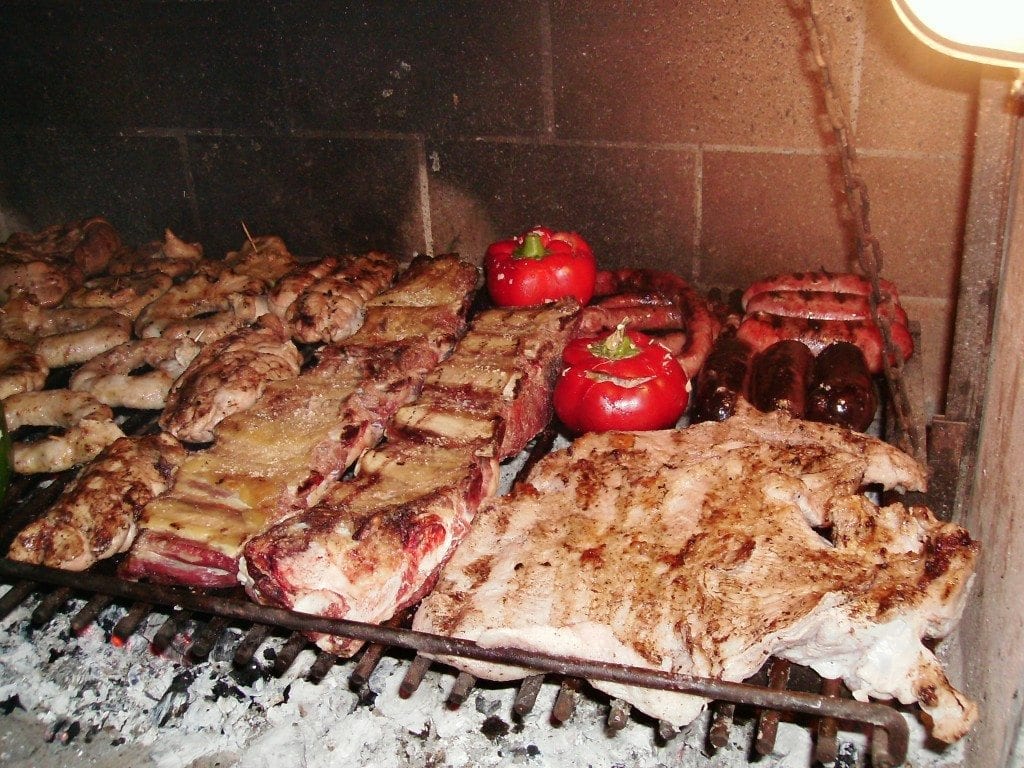
Belgrano Nightlife
As the sun sets, Belgrano comes alive with a bustling nightlife scene. From cozy wine bars to lively nightclubs, there’s something for everyone in this vibrant neighborhood.
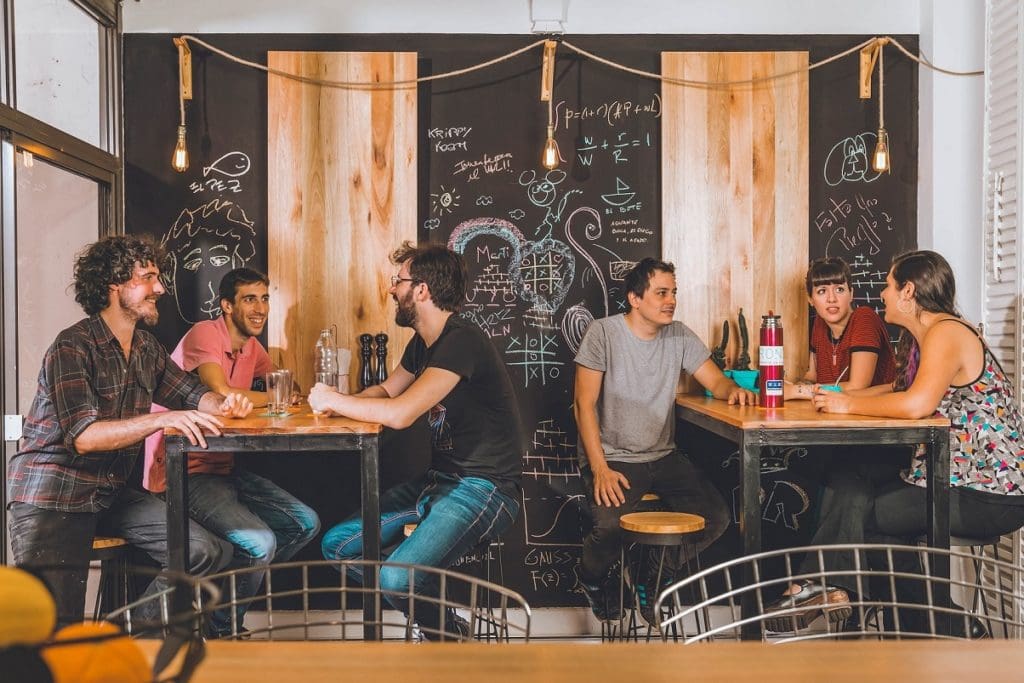
Start your night at Vico Wine Bar, a sophisticated spot that offers an extensive selection of wines from around the world. The bar’s knowledgeable staff can guide you through their menu, helping you discover new favorites. With its chic decor and relaxed atmosphere, it’s the perfect place to unwind after a day of exploring.
For those looking for a more energetic night out, Club Severino is the place to be. This popular nightclub is known for its eclectic music selection, spinning everything from Latin beats to electronic tunes. With its pulsating lights and infectious energy, it’s a hotspot for locals and tourists alike.
How Safe is Belgrano
Safety is a key concern for any traveler, and I’m pleased to report that Belgrano is one of the safer neighborhoods in Buenos Aires. Its streets are well-lit and regularly patrolled by police, making it a comfortable place to explore even after dark.
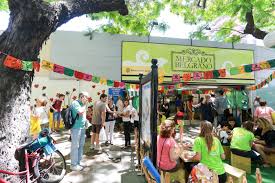
That said, like any big city, it’s important to stay vigilant. Keep an eye on your belongings and avoid displaying valuable items. It’s also wise to stick to well-populated areas and avoid taking shortcuts through unlit streets.
Also read about: 100 Barrios Part 2: Sub-Barrios of Palermo
While the overall Belgrano safety is commendable, it’s always a good idea to have travel insurance. This can provide peace of mind and financial protection in case of any unexpected incidents.
How Far is Belgrano from Downtown Buenos Aires
Belgrano’s convenient location makes it an ideal base for exploring Buenos Aires. It’s situated approximately 7 kilometers north of downtown Buenos Aires, which is about a 15-minute drive or a 30-minute subway ride.
The neighborhood is well-served by public transportation, with several bus lines and subway stations connecting it to other parts of the city. Taxis are also readily available and relatively affordable.
Despite its proximity to the city center, Belgrano maintains a peaceful, residential vibe. Its tree-lined streets and spacious parks provide a welcome respite from the hustle and bustle of downtown Buenos Aires.
What to See in Belgrano
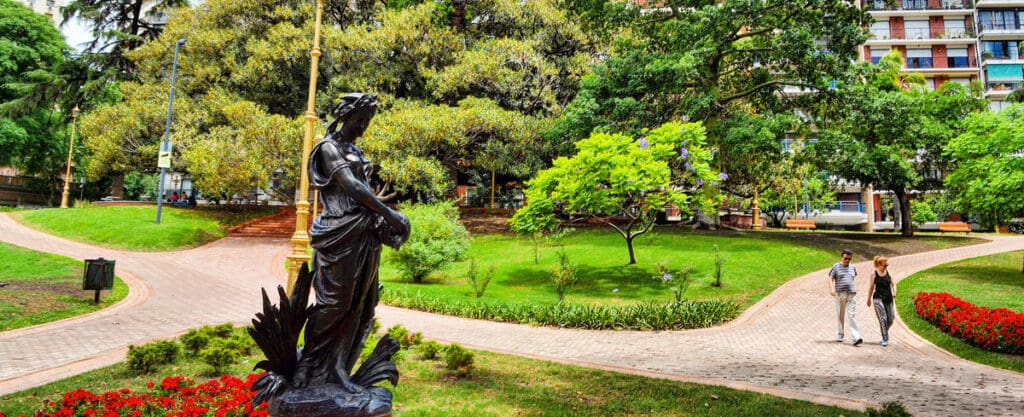
Belgrano is brimming with attractions, from historic landmarks to lush parks. One of the neighborhood’s highlights is the Barrio Chino. This small Chinatown is packed with colorful shops, bustling markets, and authentic restaurants, offering a slice of Asia in the heart of Buenos Aires.
Museo de Arte Español Enrique Larreta:
Another must-see is the Museo de Arte Español Enrique Larreta. This museum is dedicated to Spanish art from the Middle Ages and Renaissance periods. The museum is housed in a beautiful Spanish-style mansion and features a lovely Andalusian garden.
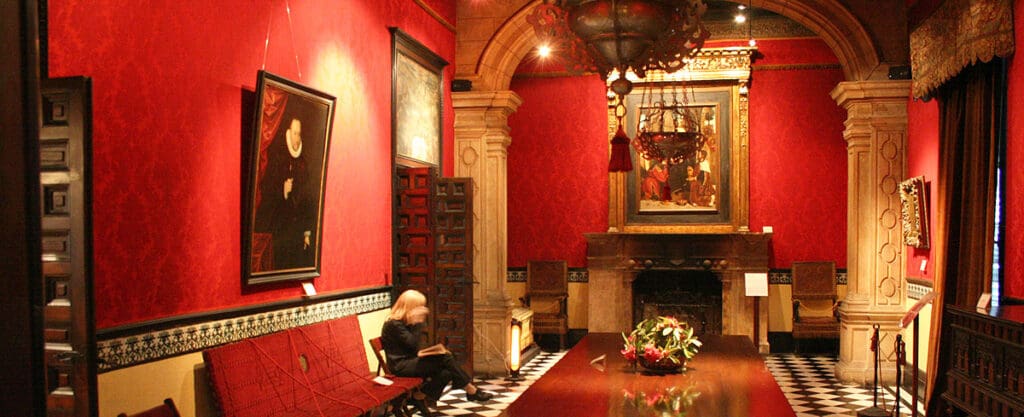
Enrique Larreta Museum
Also read our blog about: The Best Art Museums in Buenos Aires, Argentina
Belgrano Historic Spots
Belgrano is steeped in history, with several landmarks that tell the story of Buenos Aires’s past. One of these is the Sarmiento Historic Museum, the former home of Domingo Sarmiento, the seventh President of Argentina. The house has been preserved as a museum, showcasing furniture, personal items, and documents from Sarmiento’s life.
Another historic spot is the Church of the Immaculate Conception, a stunning neo-gothic church that’s one of the oldest in the city. Its intricate stained glass windows and towering spires are a sight to behold.
From its rich history to its vibrant cuisine and nightlife, Belgrano is a neighborhood that has it all. Whether you’re a history buff, a foodie, or a night owl, you’ll find something to love in this charming corner of Buenos Aires. So why wait? Start planning your trip to Belgrano today and discover its many treasures for yourself.
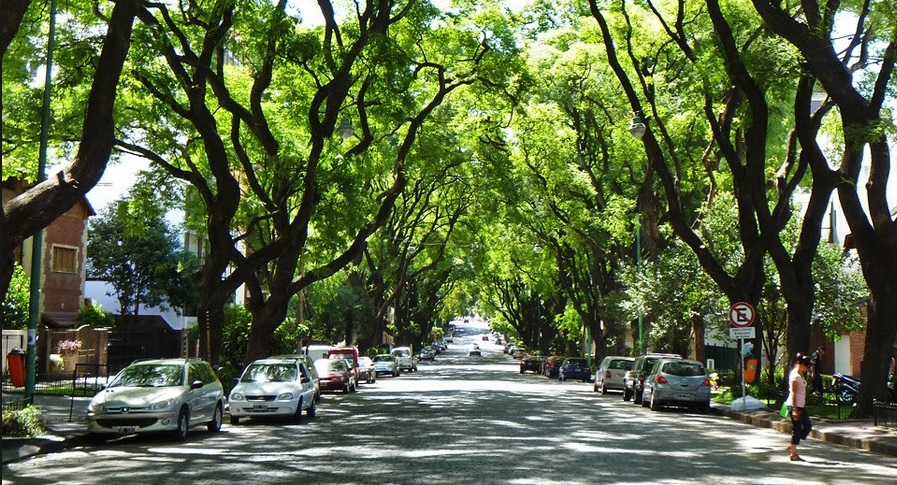
The Significance of General Manuel Belgrano
General Manuel Belgrano is not just a name; it’s a symbol of Argentina’s fight for freedom. A lawyer, economist, journalist, and politician, Belgrano is best known for his contributions to Argentina’s War of Independence. He designed the Argentine flag and led the country’s northern Army during the war.
Belgrano’s legacy is deeply ingrained in the neighborhood that bears his name. His statues and monuments dot the landscape, serving as a constant reminder of his selfless dedication to Argentina’s independence. His vision for a free and prosperous Argentina continues to inspire the people of Belgrano.
Belgrano is more than just a historical figure; he is a symbol of resilience, determination, and the indomitable Argentinian spirit. His legacy lives on in the neighborhood, inspiring generations to strive for a better future.
Discovering the Belgrano Neighborhood
Now, let’s dive into the heart of Belgrano, Buenos Aires. This neighborhood is a melting pot of cultures, where tradition meets modernity. From the bustling Chinatown to the tranquil Belgrano R, each corner of the neighborhood offers a unique experience.
Chinatown in Belgrano, Buenos Aires:
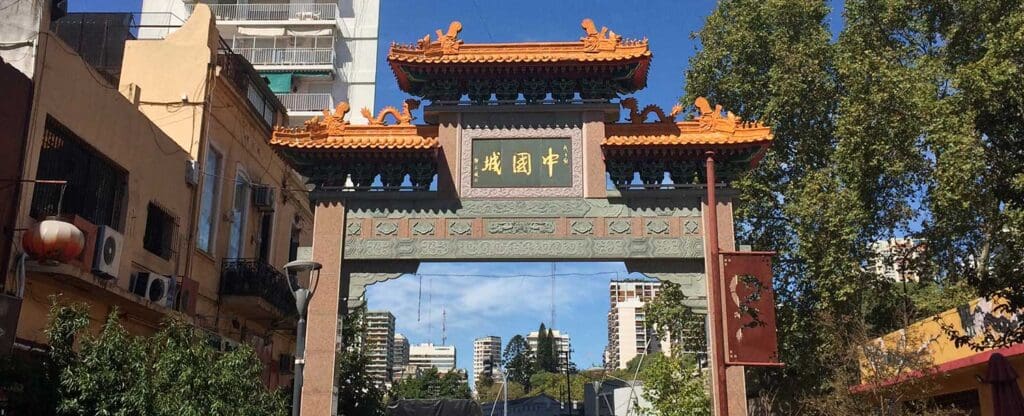
The Barrio Chino is a section of Belgrano neighbourhood with a clear East Asian identity, arising from a boom in immigration from China, Japan and Thailand in the 1980s.
These immigrant families opened numerous restaurants and supermarkets, as well as one of the city’s first buddhist temples, the Chong Kuan temple in Calle Montañeses, which was inaugurated in 1988.
Starting from the large arch at the junction with Calle Juramento, Calle Arribeños is packed with supermarkets offering both western and oriental foods, decorative objects and other products. The shops are often particularly busy at the weekends. There are a number of oriental restaurants in Arribeños and in Mendoza.
Chinese New Year is a major event in the neighbourhood, taking place at the end of January or start of February.
One of the most notable aspects of Belgrano is its stunning architecture. The district is home to a mix of architectural styles, ranging from French-style mansions to modern high-rise apartments. The tree-lined streets, the charming plazas, and the vibrant markets make Belgrano a delight to explore.
Belgrano is not just about aesthetics; it’s about the people who call it home. The locals are warm, welcoming, and proud of their neighborhood. They infuse the district with an infectious energy that makes you feel at home.
Famous Landmarks in Belgrano
Belgrano is home to several famous landmarks that are a testament to its rich history and vibrant culture. The heart of the district is the Plaza Manuel Belgrano, a charming square surrounded by stunning 19th-century buildings and dotted with beautiful sculptures.
And again, Must Must visit, the Larreta museum, housed in a stunning French-style mansion, boasts an impressive collection of Spanish art. The museum’s garden, inspired by Moorish designs, is a tranquil oasis in the heart of the bustling city.
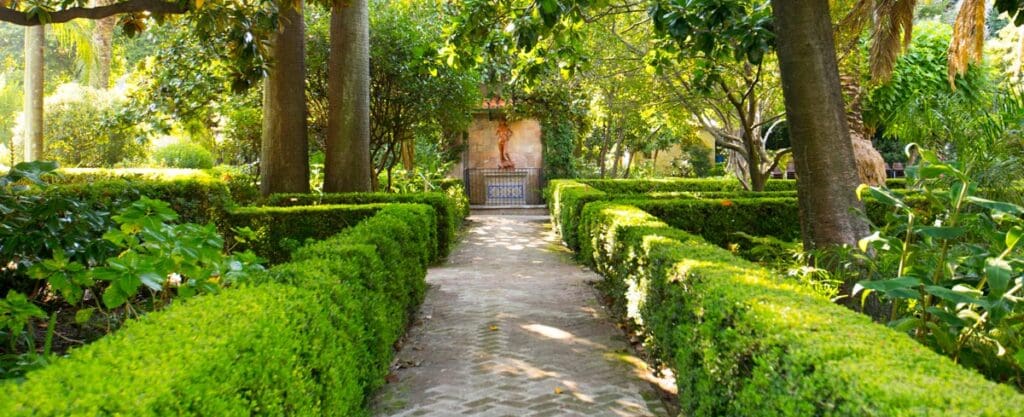
The neighborhood is also home to the Iglesia de la Inmaculada Concepción, a stunning church with beautiful stained glass windows and an imposing bell tower. This church, also known as “La Redonda” due to its circular shape, is a landmark in its own right.
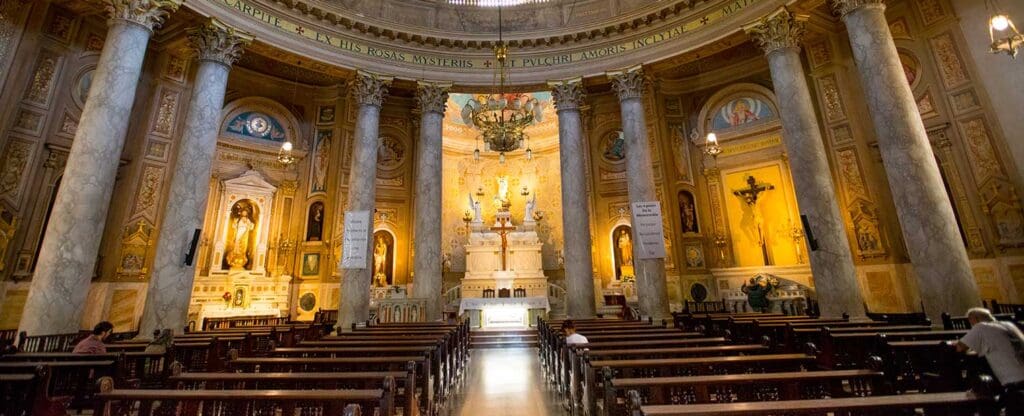
University of Belgrano: A Center of Academic Excellence
The University of Belgrano, one of the most prestigious educational institutions in Argentina, is another feather in Belgrano’s cap. Established in 1964, the university offers a wide range of undergraduate and graduate programs, attracting students from across the globe.
The university’s modern campus, located in the heart of Belgrano, is a hub of academic activity. With a strong focus on research and innovation, the University of Belgrano is shaping the future of Argentina and the world.
The university’s diverse student body adds a youthful energy to the neighborhood. The students, with their dreams and aspirations, are an integral part of Belgrano’s vibrant community.
If you choose to study at Belgrano University, you should first consider taking Spanish Classes in Buenos Aires. Vamos Academy offers both Online Spanish Classes and In-Person.
Shopping in Belgrano: Where to Go
Belgrano is a shopper’s paradise, offering a wide range of shopping options. From high-end boutiques to quirky independent shops, the district has something for every shopper.
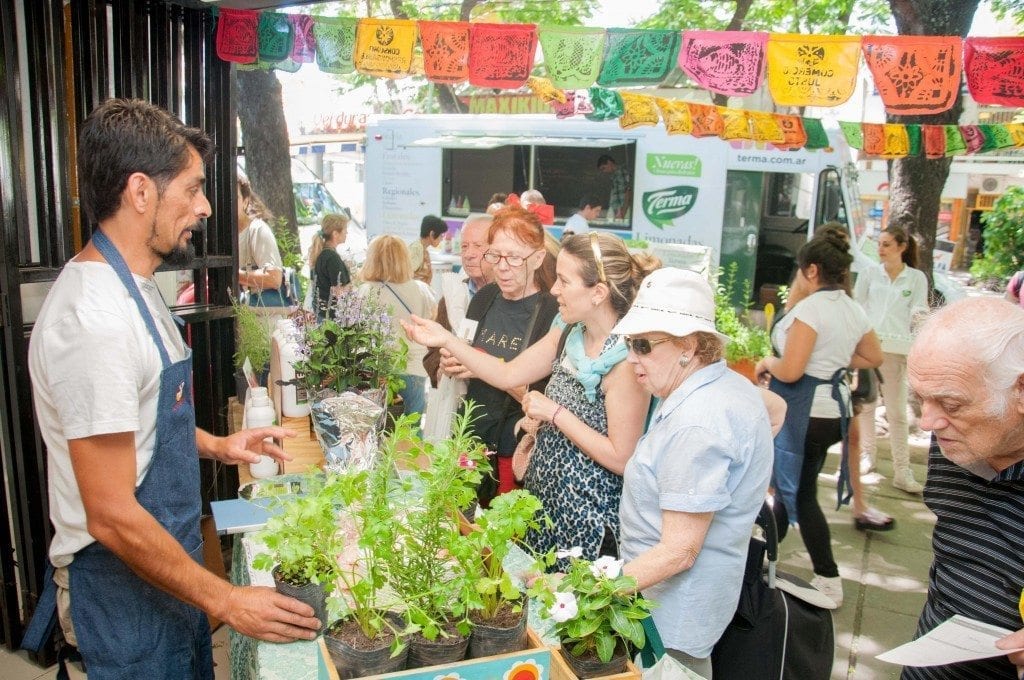
Avenida Cabildo, the main shopping street in Belgrano, is lined with a plethora of shops and boutiques. Here, you can find everything from fashionable clothes to unique souvenirs.
If you’re looking for a more unique shopping experience, head to the Feria de Belgrano. This open-air market, held every weekend, is a treasure trove of antiques, handmade crafts, and local delicacies.
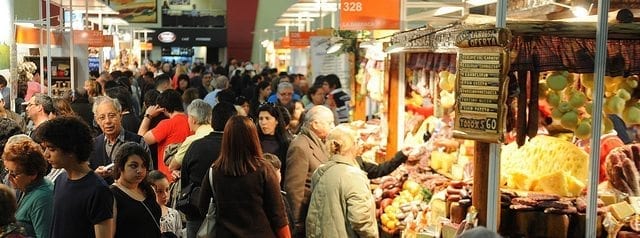
Conclusion: Why Belgrano is Buenos Aires’ Hidden Gem
Belgrano, with its rich history, vibrant culture, and warm community, is undoubtedly a hidden gem in Buenos Aires. Whether you’re a history buff, a foodie, a sports enthusiast, or a shopaholic, Belgrano has something for you.
So why wait? Come and uncover the secrets of Belgrano, Buenos Aires. You won’t be disappointed!
And while you’re in Buenos Aires, why not learn Spanish? Come to Vamos Academy, the best Spanish School in Malaga and Buenos Aires. We offer in-person group and private Spanish Classes for students of all levels and ages. Start Your Spanish Immersion Experience in Argentina today!

The Excitement of Club Atlético Belgrano and Defensores de Belgrano
Football is more than just a sport in Argentina; it’s a way of life. And in Belgrano, this passion for football is palpable. The neighborhood is home to two popular football clubs, Club Atlético Belgrano and Defensores de Belgrano.
Club Atlético Belgrano, often referred to as “El Pirata” (The Pirate), has a rich history dating back to 1905. The club’s stadium, Estadio Julio César Villagra, also known as “El Gigante de Alberdi,” is a must-visit for any football fan.
Defensores de Belgrano, also known as “El Dragón,” is another beloved football club in the neighborhood. The team’s matches at their home ground, Estadio Juan Pasquale, are filled with excitement and energy.
Also Read: Buenos Aires Football Stadiums
The Thrilling Encounter: Belgrano vs Huracán
One of the most exciting sporting events in Belgrano is the football match between Club Atlético Belgrano and Club Atlético Huracán. Known as “El Clásico,” this match is a high-stakes battle between two of Argentina’s most popular football clubs.

The energy in the stadium during El Clásico is unparalleled. The roar of the crowd, the intense rivalry, and the exhilarating action on the field make it an unforgettable experience. Whether you’re a die-hard football fan or just a casual spectator, El Clásico is a must-see event.
Why the Name: Belgrano Avenue
Joaquín del Corazón de Jesús Belgrano, commonly known as Manuel Belgrano, is celebrated as one of Argentina’s Founding Fathers. He played a pivotal role in the Argentine War of Independence (1810-1818) and is credited with designing the national flag.
Born in Buenos Aires, Belgrano was educated in Spain towards the end of the 18th century, during the Age of Enlightenment. Despite his father’s wishes for him to study commerce, he pursued law instead. His time in Europe, marked by the American and French Revolutions, brought him into contact with Spain’s intellectual elite, sparking a particular interest in the notions of public good and popular prosperity.
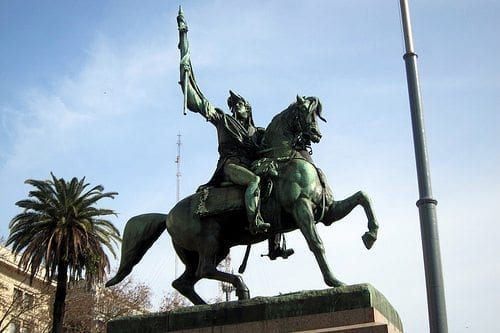
Prior to his return to Argentina, Belgrano was elected as the “perpetual secretary” of the Commerce Consulate of Buenos Aires, handling commercial and industrial matters in the Viceroyalty of Rio de la Plata, of which Argentina was a part. Although he retained this position until the onset of the war in 1810, he was unable to implement many desired changes. For instance, he established several educational institutions, only to see them closed by the Spanish government three years later.
The Peninsular War saw France occupying Spain and dethroning King Ferdinand VII. Initially, Belgrano supported Ferdinand’s sister, Carlota Joaquina, for the throne, but faced considerable resistance. Around this time, he mingled with revolutionaries, ostensibly for developing a newspaper, Correo de Comercio.
In 1810, resigning from the Consulate, Belgrano retreated to the countryside. However, the May Revolution drew him back into political action upon the urging of friends. The revolution, spurred by further defeats of the Spanish government, led to the formation of the Primera Junta, with Belgrano as a member.
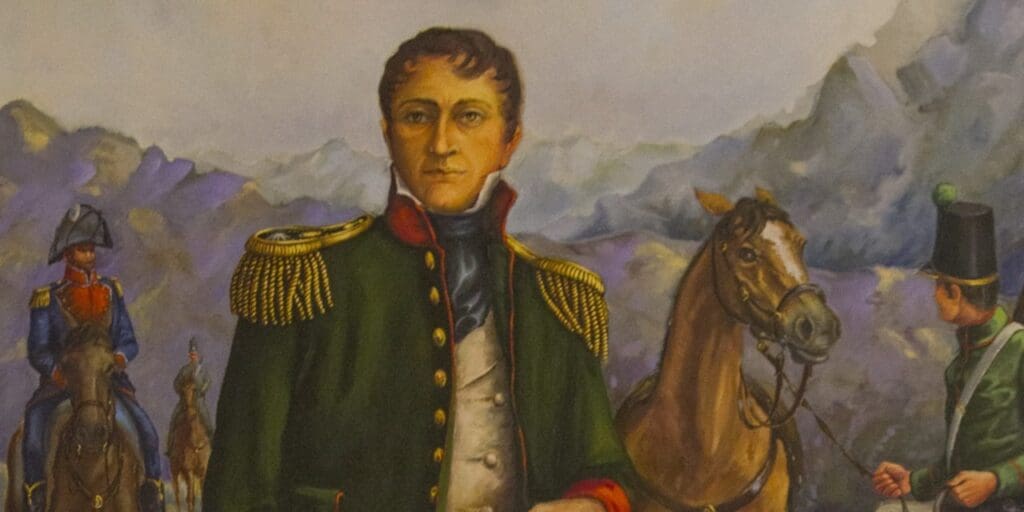
Appointed Chief Commander of an army by the Primera Junta, Belgrano designed the Flag of Argentina upon realizing that both patriots and loyalists had been fighting under identical colors. Initially rejected, the flag was finally accepted in July 1816, coinciding with Argentina’s Declaration of Independence from Spain. His early military campaigns included an ill-fated attempt in Paraguay, followed by a more successful stint as the leader of the Army of the North, where he led significant victories despite occasional setbacks.
Post a failed mission to Europe seeking support for independence, Belgrano returned to Argentina, proposing the Inca Plan to establish a constitutional monarchy under an Inca noble. The idea faced strong opposition, especially in Buenos Aires, and was never realized.
Belgrano resumed command of the Army of the North in August 1816, holding the position until illness forced him to step down in 1819. He passed away on June 20, 1820, at the age of 50, leaving behind a legacy as a formidable politician, military leader, and the creator of Argentina’s National Flag. His commemorative statue stands proudly in front of the Casa Rosada in Plaza de Mayo, honoring his indelible contributions to Argentina’s identity and independence.




